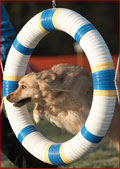Agility Training Your Dog Safety Tips
Agility training your dog can have many positive side effects. Aside from providing much-needed mental and physical exercise for your canine (and possibly yourself), agility training will also contribute to your pet being a healthier and happier pet.
If you would like to start your own dog agility training, you should pay attention to and follow these safety tips:
Health Check
While agility training your dog can be great fun for you and your dog, you should at least have your veterinarian examine your pet first before you go ahead with the training. Dogs that have any medical history or joint related problems should not participate in any agility training. Dogs that are overweight should be put on a diet first before attempting agility.
Jumping Precautions
Keep in mind not to set your obstacle such as the tire jump too high so that your dog will not stress or injures itself while jumping - ideally the placement should be around your dog's shoulder height.
Avoid training on concrete surfaces as it will be very stressful on your dog's joint. Carpeted or grassy areas are highly preferred. Dry all the surfaces possible and provide good traction especially on the take off and landing area. Cover with carpets or car mats if the field is wet and drying is not an option. Keep your dog's nails short so that it will not hurt itself when landing.
Don't Rush Your Dog
Agility training your dog should be a fun and positive experience. Never force your dog to go through an obstacle if it is frightened or unsure. Instead, use positive body language or food treats to guide it through. Alternatively, you can lead your dog by leash over small jumps to build your dog confidence.
Keep the training sessions short so that you don't overwork your dog. Reward him/her when it completes each obstacle successfully.
Speed And Timing
While speed and fast timing is an important factor in the sport of agility, your dog should only be made to go the obstacles with pace when he/she has shown confidence in negotiating the entire agility course.
And remember; always end all the training on a positive note. If you can manage to do all of things when agility training your dog, there is no limit to the amount of pleasure you will experience. Perhaps nothing in this world is as rewarding as teaching your old (or young) dog new tricks and you may even learn a new trick or two in the process also!
From: DogTrainingClassroom.com

 Agility
Agility 





Reader Comments